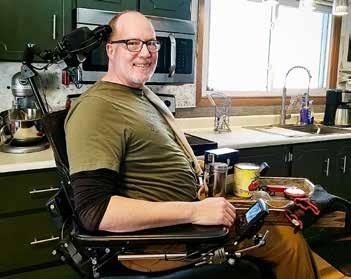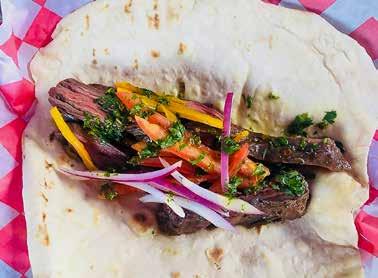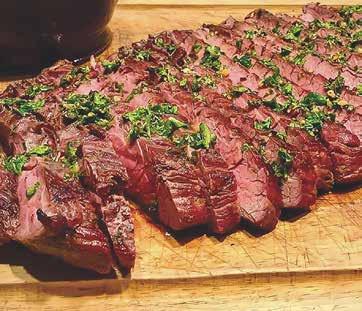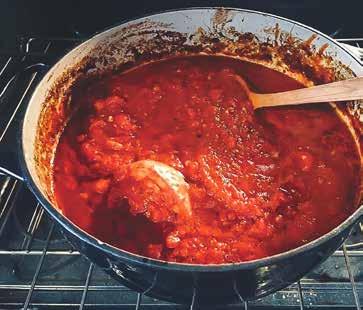
11 minute read
FOOD

La Crosse resident Richard Chrz savors the mental aspects of cooking as much as the finished product.
Advertisement
ROLLING WITH THE CHANGES
Cooking and meditation provide Richard Chrz with a path through chronic illness and life.
BY JULIE NELSON | CONTRIBUTED PHOTOS
Life is about Yin and Yang. You must get comfortable in the down area so you appreciate the good. The key is to go with the natural flow and think about the stories you are telling yourself, the script that is in your head. This is where growth comes from.”
These words of wisdom come not from a Buddhist monk nor a popular podcast, but from Richard Chrz, a 48-year-old La Crosse man who lives with chronic pain and fatigue.
Chrz (pronounced Kriz) was diagnosed with lupus in July 2010. Since then, the autoimmune disorder has attacked his nervous system to the point where Chrz has to carefully consider when and how he uses his arms and hands each day, and his legs are no longer strong enough to even hold him in a sitting position. But that’s just his body: Chrz’s mind is going full steam ahead. Chrz has a great sense of humor and is one of the most upbeat people you could ever hope to be around. When it comes to finding and maintaining his positive attitude, he gives the women in his life a lot of the credit.
FINDING PEACE IN MEDITATION AND COOKING
Earlier in his diagnosis, Chrz was spending six hours a day in a hospital receiving a chemo drip to fight the lupus. Talk about boring. And frustrating. “My sister, who is a nurse, had just been to a conference on mindful body stress reduction meditation and health care,” he says, “and she suggested I try it.” He spent his next six-hour sessions meditating on what he can and cannot control. The meditation changed his outlook. He now sees himself as walking alongside the disease, not as a victim to it. When his physical abilities change, Chrz—with much support from his wife, Renee—adapts and finds a way to keep living.
One way he discovered to roll with the changes was through food. “I’ve always liked looking at food. I’ve always seen the art in it, and of course, I like eating it,” he says. He decided to tackle the process of learning to cook and now lists his specialties as sourdough bread, charcoal-cooked brisket and homemade pizza.
“Though there may be some of my former teachers who disagree with this,” he quips, “I’ve always liked learning. My cookbooks are more like science books. If I know why different ingredients act the way they do, I can figure out the how, without a recipe.”
ADAPTING TO THE POSSIBILITIES AND REALITIES
This approach is what has made the sourdough a possibility for him, though his hands are no longer strong enough to knead the dough. He says bread baking has been a lesson in resilience; by understanding what has to happen in the mixing and kneading, he was able to create his own ways of doing it. Sourdough bread is ideal for Chrz because it doesn’t happen all at once. He feeds the starter two days before he plans to do the kneading, and while the bread is rising, Chrz is resting.
Chrz says that’s also why he’s become so good at brisket. He’s figured out how to keep charcoal at 225 degrees for 20 hours straight, which means he doesn’t have to attend to it constantly. “I make food that I can sleep through,” he says with a laugh.
Pizza is a week-long process. He spends the first part of the week chopping the ingredients, and then the dough is made over three days. When it’s time to dine, cooking is a simple assembly process. With Renee there to open the oven door, the pizza is ready in no time.
Even more so than a carpenter, Chrz has to think twice and act once in his cooking process. The Chrz house doesn’t have adapted counters; instead, Richard’s chair will elevate to the height needed. That means if he drops something, it’s an annoying ride down to pick it up and another putzy ride back up to get to the counter. Going from the counter to the pantry involves a three-point turn in his wheelchair, so Chrz wants to make darned sure he has every ingredient he needs before getting to work. He has a tray with edges on it to collect supplies, and sometimes his lap serves as the most convenient place for a cutting board. For Chrz, the mental challenge of determining the strategy and logistics is part of what makes cooking fun.
ANTICIPATING CHANGES WITH CONFIDENCE
Chrz reserves as much energy as he can for the weekends, when he will make big meals with leftovers that can easily be created into something new on weeknights. Of course, there are times when his
body doesn’t cooperate with his plans, and he wakes up on a weekend morning knowing he will have to put his cooking plans aside. “That’s my life,” he says. “I try not to dwell on the negative or attach myself to any one thing, other than learning.”
Though Renee is willing to help with the kitchen tasks, Chrz takes pride in being the one to provide the meals and does 99 percent of the cooking. Renee opens the oven door and lifts the 20-pound bag of charcoal, but Chrz does nearly everything else himself. He even enjoys washing the dishes. “I treat it as a meditation,” he says. “I remember the food I selected, the dishes I prepared and the way they tasted. I am grateful for the food, for our house and even the warm water I am washing in.”
While Chrz may always be able to soak his hands in warm dishwater, he recognizes the day will come when he won’t have the hand strength to prepare the food or perhaps even hold the plates in the sink. Yet his strategic brain is already kicking into gear. He enjoys taking pictures of his food and could shift more toward photography. He also has a wealth of knowledge about cooking techniques, adaptive kitchen tools and meditation that he enjoys sharing. He could foresee doing a video blog or even product reviews for adaptive equipment on his YouTube channel.
However bumpy the road is ahead, Chrz knows he and Renee will roll over it together. “My wife is my rock,” he says. “She is always there to help when I need to ask for it, and yet she is gracious in giving me the space to be as independent as possible.” There is no cure for lupus, and the changes happening to his body are forever. In some ways, the disease has made them stronger as a couple. “We know what we need from each other as we learn to flow through this together,” he says. “It is a team approach.
“I practice life; that’s my motto. At the end of the day, you’ve got to be kind to yourself. Forgive yourself for anything that maybe you weren’t proud of or you could have done better. I just say that’s today. Tomorrow I get to practice life again.” CRW
Julie Nelson is a Coulee Region writer who is inspired by Richard’s resilience and sense of gratitude. She has even offered to let him do some of his meditation over the sinkful of dirty dishes at her house. PRO TIP FROM RICHARD CHRZ
A good meat thermometer is worth the minimal investment in saving your meals from being under- or overcooked. My favorite is the ThermoPop by ThermoWorks. I have abused the heck out of it—it’s been dropped so many times.
Strength matters second to accuracy, and it’s super accurate. In addition to accuracy and durability, I prefer them for their “accessible” view. The size of the face is good for dexterity, I can put it in my hands, even with somewhat of a closed hand, and still read it. The display rotates all directions if needed. It has a plastic face that never feels hot, so it is safe even for those with sensory issues.
Most importantly, it’s affordable and it’s accurate—less than $35. The difference it will make in your cooking will increase your patio game to the upper level of neighborhood grill master.

You’re doing a lot … it’s OK to wine about it.
There’s an iconic Calgon bubble bath commercial: A mother with everything on her plate getting pulled in a million different directions calls out, “Calgon, take me away!” She’s instantly transported to a luxurious, serene bubble bath.
Today, more than ever, we need that—a reset button on our lives to refresh and invigorate our daily grind. Fortunately, it is available through a Picnic Package or a Take Home Tasting & Zoom experience. Now more than ever, we need to take time to slow down, enjoy some company, and savor some exceptional wine.

Carne Asada with Fresh Chimichurri Sauce
Chimichurri
½ cup parsley, finely chopped ¼ cup cilantro, finely chopped 2-3 cloves garlic, minced 1 cup olive oil ¼ cup freshly squeezed lemon (about one lemon) 1 T oregano 1 T crushed red pepper ½ T kosher salt, or to your taste
Mix all ingredients well. This may be made no more than 7 days in advance and stored in the refrigerator.
Flank steak
1 flank steak, 1¾-2½ lbs.
Trim the thin side off the steak.
Run a knife up and down with the grain to loosen up the cut and trim the fat off. Rub with a mixture of salt, pepper and cumin. By loosening up the cut with little slits, it allows the seasoning (and the grill flavor) to soak into the meat further.
Set up two-zone cooking on a charcoal grill (coals and fire on one side, nothing on the opposite side)—you can also set up a cool side to move the meat to if needed. Grill and flip the steak every minute or two, to get equal grill flavor evenly for each bite. Use a quality thermometer probe to temp the meat. If the thicker side is slow to match, leave the thinner side on the non-flame side of the grill, and the thicker on the side with flames.
Throw the trimming from the thin side of the steak on the grill at the same time. This will cook much faster, and cooking them separately prevents an inconsistent cook on your main cut. These little bits are also your reward for cooking.
When you cut the flank steak, it is important to slice it thinly and across the grain. This makes for a better eating experience. We like to serve it as carne asada on grilled flour tortillas with the chimichurri sauce poured over. Dress it up however you would like.

Red Sauce
4 28 oz. cans of whole peeled San Marzano tomatoes ¼ cup olive oil 8 cloves garlic, finely chopped (or roughly 3 T of store-bought pre-minced garlic) 2 T butter 1 tsp. dried oregano 1 tsp. red pepper flakes 1 medium onion, split in half (you can leave the skin on it) 1 large stem of fresh basil 1 large carrot cut in 3 sections (for dexterity and hand weakness substitute 4 mini carrots) Salt and pepper to taste
Start with a large 5-quart Dutch oven, something with handles that can go in the oven for 6 hours. Add the butter, oil and garlic, and let them warm up together slowly, which releases more aroma. Add in the oregano, red pepper flakes, salt and pepper to taste—start with less and add as it simmers. Continue to cook for another minute.
Crush the tomatoes by hand and add them to the pot. (You can also use a stick blender, countertop blender, hand mixer, etc.) Two important notes: 1. Do not make this completely smooth; leave a few chunks in it. 2. Choose whole peeled tomatoes, which are generally the best tomatoes. Tomatoes with bruising or flaws can be hidden in pureed and finely chopped versions. It is important to start with a quality whole tomato like the San Marzano from Italy, which are available in various brands at local stores.
Add in the large stem with leaves of basil, the two onion halves and the carrots; you will scoop all of these out at the end.
Bring it up to a small simmering boil over high heat, put the lid on the Dutch oven and then transfer it into an oven at roughly 190°, stirring every hour or two. Check on it early to see how it is cooking; you don’t necessarily want it boiling, a little simmer is good. I generally take it out around the 6-hour mark.
When done, take out onions, carrots and basil. This can be used immediately or stored in containers.










